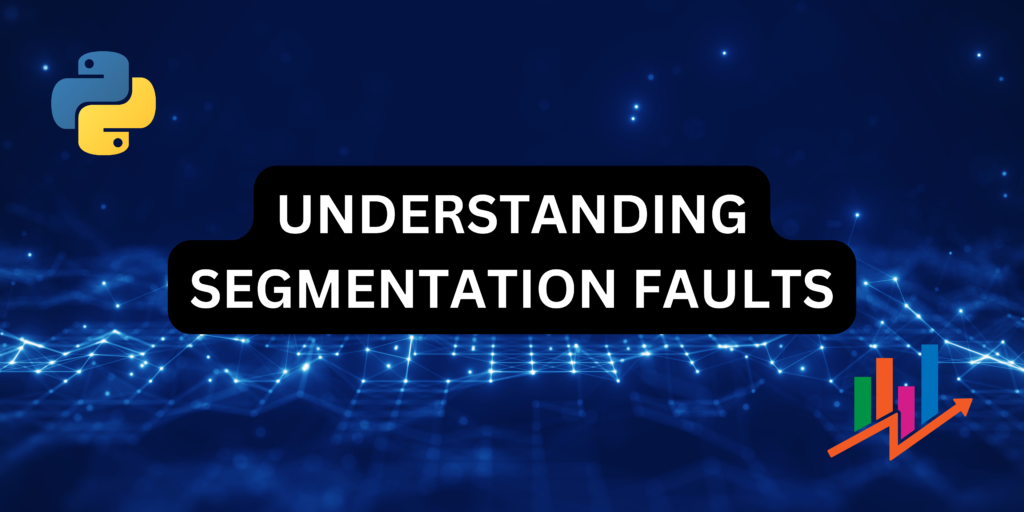A segmentation fault occurs when a program attempts to access a memory location that it is not allowed to access. This can happen for several reasons, such as trying to access an uninitialized or deallocated memory location, attempting to write to read-only memory, or simply trying to access memory outside of the program’s allocated memory space.
Segmentation faults are a common type of error that can occur in programming languages like Python, C, and C++. These faults happen when a program tries to access memory locations that it is not allowed to access, leading to a crash or unexpected behavior. While Python’s memory management system helps prevent many segmentation faults, they can still occur in certain cases, especially when working with external libraries or low-level code.
Let us now try to understand how to eliminate these Segmentation Faults.
Now there are certain ways to get rid of segmentation faults. It is through Memory Management and Debugging. Let us understand it further.
Recommended: How to Fix the ‘Class’ object has no ‘attribute_name’ Error in Python
Eliminating Segmentation Fault through Memory Management
Memory Management is essentially the process of coordinating how computer memory is utilized. Now let us understand with certain examples the concept of memory management better.
Managing Object Lifespans
Long-lived variables that exist for a long time should be avoided if they get deallocated later. Moreover, in the case of Segmentation Fault, we need to be wary of external libraries and how they manage memory. Python’s garbage collection usually handles the object’s lifespans to make it less prone to segmentation faults. Let us look at the Python code to understand further.
import numpy as np # Example of an external library
arr = np.zeros(10) # Create a NumPy array
# array remains accessible here
# Clean up before leaving the scope
del arr # Deallocate the array explicitly
The above code is to handle external libraries. Let us look at the code to avoid long-lived references.
def create_large_object():
return "A very large object" * 100000 # Hypothetical large object
# Don't store a long-lived reference to a temporary object
# object_ref = create_large_object() # Avoid this
# Access the object directly within its scope
print(create_large_object()) # Object is garbage collected afterward
Avoiding Dangling Pointers
Let us suppose that Python is a librarian and has to keep track of each book. When someone issues a book, memory is occupied, whereas memory is freed when the book is returned. A segmentation fault happens when someone tries to return a non-existent book. In short, a dangling reference refers to an object that no longer exists. Let us look at an example to understand further.
// segfault_module.c
#include <Python.h>
static PyObject* segfault(PyObject* self, PyObject* args) {
int* ptr = NULL;
*ptr = 42; // Attempting to dereference a null pointer
Py_RETURN_NONE;
}
static PyMethodDef methods[] = {
{"segfault", segfault, METH_NOARGS, "Cause a segmentation fault"},
{NULL, NULL, 0, NULL}
};
static struct PyModuleDef segfault_module = {
PyModuleDef_HEAD_INIT,
"segfault_module",
NULL,
-1,
methods
};
PyMODINIT_FUNC PyInit_segfault_module(void) {
return PyModule_Create(&segfault_module);
}
The above example can lead to a segmentation fault. Let us look at the output.

Handling Edge Cases
An edge case is a problem that occurs only at the extremes ( maximum or minimum ) of the assumed parameter. To avoid edge cases regarding Segmentation Faults, we must be very careful when using external libraries. Moreover, using recursive methods also helps to avoid exhausting memory, which eventually helps with avoiding Segmentation faults. We also need to avoid storing references to objects in variables that might be deallocated later.
Eliminating Segmentation Faults Using Debugging
Let’s find a way to eliminate segmentation faults using debugging.
Using the Faulthandler Module
The Faulthandler module in Python helps detect segmentation faults. It builds a traceback that shows the line of code where the fault happened. Let’s look at the code to understand it further.
import faulthandler
faulthandler.enable()
def cause_segfault():
x = None
print(x[1]) # This line will cause a segmentation fault because x is None
cause_segfault()
Using Debuggers
Debuggers help you check the code line by line, observe the variables, set breakpoints in the code, and pause execution at those points. They can also give you valuable insights about the error and help you analyze the error message.
Conclusion
Segmentation faults can be tricky to debug and fix. Still, by understanding the underlying causes and employing proper memory management techniques and debugging tools, you can effectively identify and resolve these issues in your Python programs.
Prevention is key, so always be mindful of object lifespans, avoid dangling pointers, and handle edge cases carefully, especially when working with external libraries or low-level code. You can write more robust and reliable Python code with the right approach. How can you ensure that your Python code remains free from segmentation faults, even as your codebase grows and becomes more complex over time?
Recommended: Debugging Elif Syntax Errors in Python
Recommended: Tricks for Easier Debugging in Python
